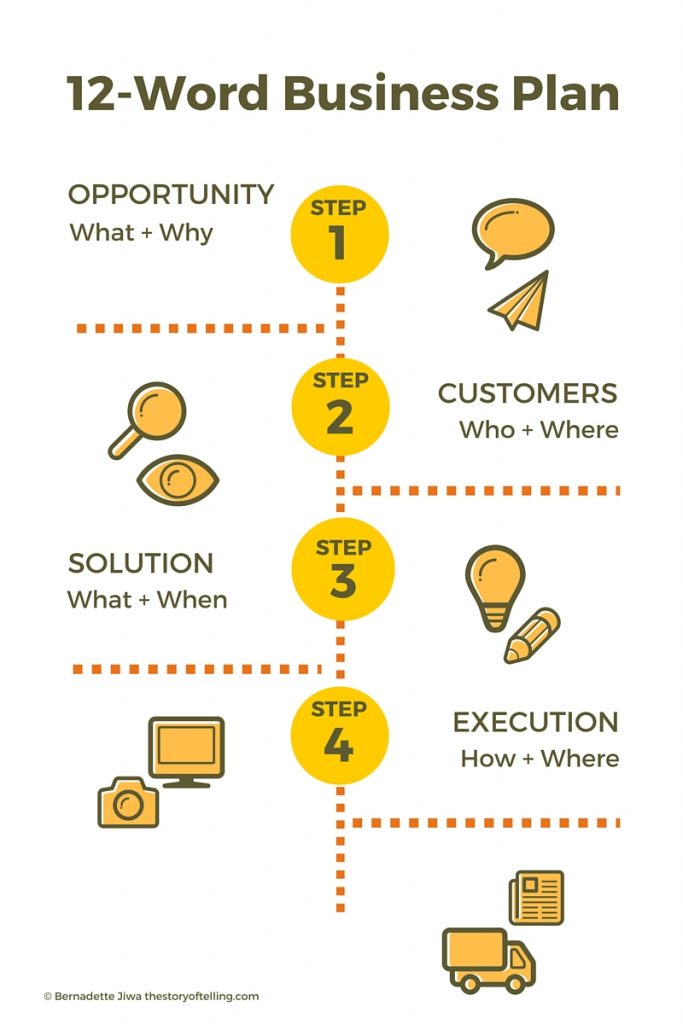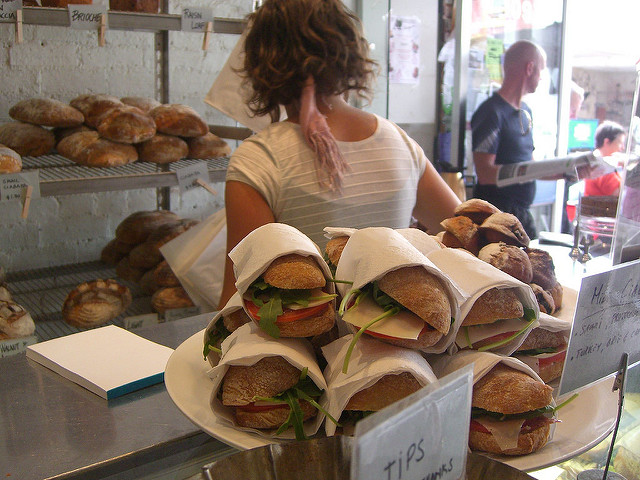Unlock the Magic in Your Story Now
Get the Free 20 questions to Ask Before Launching Your Idea workbook when you sign up for occasional updates.
Get the Free 20 questions to Ask Before Launching Your Idea workbook when you sign up for occasional updates.
Articles filed in: Strategy
Evaluating Opportunities
 Opportunities are presented to us every day. It’s not always easy to discern which ones are worth taking and which ones to pass on. What questions do you ask yourself before you decide which to pursue or pass up?
Opportunities are presented to us every day. It’s not always easy to discern which ones are worth taking and which ones to pass on. What questions do you ask yourself before you decide which to pursue or pass up?
10 Questions For Evaluating Opportunities
1. Why are we considering this opportunity?
2. What’s the biggest risk?
3. Do the potential gains outweigh the possible disadvantages?
4. How can we take advantage of the opportunity while mitigating against the risks?
5. How exactly will this help our brand?
6. What will success look like?
7. Are we happy about how much control we will have over the outcome?
8. Do the values of the potential partners closely align with ours?
9. If we say ‘yes’ to this what will we have to say ‘no’ to?
10. Does this feel like the right thing to do?
It’s better to question now rather than later.
Image by Jaine.
The 12-Word Business Plan
 Have you ever struggled to illustrate or articulate how your business or idea creates value?
Have you ever struggled to illustrate or articulate how your business or idea creates value?
This 12-word framework is the simplest way to do it.
Take a look at how we could map Blue Apron’s business plan using the 12-word framework.
Blue Apron’s 12-Word Business Plan
OPPORTUNITY
People want to eat healthy, home cooked meals, but they don’t have the time and skills to cook.
CUSTOMERS
Health conscious, time poor, couples and families in urban centres.
SOLUTION
Fresh, competitively priced meal kits, conveniently delivered to the customer’s door every week.
EXECUTION
Step-by-step recipes designed to help customers succeed and save time on meal planning.
Seasonal ingredients sourced directly from farmers and producers. Freshness and quality are assured.
Portioned ingredients, means no waste.
Customers choose and pre-order kits online, saving time on meal planning and grocery shopping.
Free delivery at times to suit customer’s schedule. No more battling traffic and supermarkets.
Healthier, more convenient, fun and less wasteful than meal planning, shopping, and preparation.
We win by sourcing well, bulk purchasing, predicting demand, managing distribution, scaling, supporting suppliers and delighting customers.
Over to you. What does your 12-Word Business Plan look like?
Image by Giselle Leung.
What Is A Strategy?
 In business, we use words that are designed to help us to better understand, articulate and achieve our objectives. Often those same words end up doing exactly the opposite. ‘Strategy’ is one of those words that can tie us up in knots if we allow it to.
In business, we use words that are designed to help us to better understand, articulate and achieve our objectives. Often those same words end up doing exactly the opposite. ‘Strategy’ is one of those words that can tie us up in knots if we allow it to.
Imagine you’re on a riverbank. The place you want to get to—your destination is on the other side.
There is no bridge in sight and no obvious way to cross. There might be others on the riverbank trying to cross at the same time. You need a plan to get from here to there. So, you make a decision to cross the river at this spot, rather than keep heading upstream. The goal is to reach the other side within a set period of time and to monitor your progress as you go. You’ve committed to a plan—this is your strategy. The strategy doesn’t detail how exactly you will get across.
Next, you decide that you’ll use stepping stones to create a walkway, rather than build a boat to row across. Decisions like what kind of stones you’ll use, where you’ll get them from or who’ll be responsible for working out how far apart they’re placed are tactical.
When we break this down it looks something like this:
GOAL = DESIRED OUTCOME
STRATEGY = COMMITMENT + PLAN
TACTICS = PROCESS + ACTIONS
Or expressed another way:
GOAL = THE WHY & WHAT
STRATEGY = THE WAY
TACTICS = THE HOW TO
Rising river levels or bad weather might mean you have to change tactics but the strategy remains the same, if and until you discern that it isn’t the best way to achieve your goal. Then you pivot, but that’s a whole other story.
The best example of a strategy you are likely to see is Amazon’s—as detailed by Jeff Bezos is his annual letter to shareholders starting back in 1997. When you can get as clear as Jeff you know you’ve got a strategy.
Image by Haldean Brown.
A Question Of Tactics
 When marketers had no choice but to pay thousands of dollars each year for print, TV or other forms of conventional advertising they had to discern which media to invest in and why.
When marketers had no choice but to pay thousands of dollars each year for print, TV or other forms of conventional advertising they had to discern which media to invest in and why.
The good ones had a strategy. The rest dabbled.
In a digital world though, it seems like every day there’s another opportunity to expand our reach for free. A new platform to try, another channel where the eyeballs are—a place where you should have a presence. And so we invest time (which of course is not free), executing on tactics in the hope of making gains we haven’t yet clearly defined. A strategy should still come before tactics.
7 Questions to ask before allocating marketing resources
1. Why should we invest in this channel or platform and why now?
2. How will this benefit our brand?
3. How will this benefit our customers?
4. How will we measure if it’s working?
5. What’s the opportunity cost of devoting resources here and not there?
6. What other opportunities exist to invest in growth by delighting existing customers?
7. If this is the right thing to do, how are we going to be the best in the world at it?
Do you have a plan or are you just dabbling?
Image by Hernán Piñera.
Marketing Inversion
 When Amazon.com was still in its infancy, Jeff Bezos, the company’s founder and CEO had this to say; “In the old world, you devoted 30% of your time to building a great service and 70% of your time to shouting about it. In the new world, that inverts.”
When Amazon.com was still in its infancy, Jeff Bezos, the company’s founder and CEO had this to say; “In the old world, you devoted 30% of your time to building a great service and 70% of your time to shouting about it. In the new world, that inverts.”
Shouting brought us Pop Tarts, Alka Seltzer and Sardine & Mackerel flavoured Entrée cat food, that’s 8% crude protein, packaged in the Flavor-Lock™ pouch. Building on the other hand, gave us 1-Click ordering, Kindle and free shipping.
Are you spending most of your time building or shouting?
Image by Megan Trace.
Owning The Story
filed in Storytelling, Strategy
 The little deli around the corner just started opening an hour earlier on weekday mornings. Of course, it makes sense for a business located in a walkable neighbourhood to serve commuters who will grab a coffee on the way to work and maybe even buy a sandwich for lunch later in the day.
The little deli around the corner just started opening an hour earlier on weekday mornings. Of course, it makes sense for a business located in a walkable neighbourhood to serve commuters who will grab a coffee on the way to work and maybe even buy a sandwich for lunch later in the day.
The last time I was there I got chatting to one of the assistants.
“Why did you decide to open earlier in the morning?” I asked.
“Oh, ‘they’ (meaning the management) wanted to give it a go to see how it went,” she replied.
Sadly we disown our role as part of the collective in this way all the time. We talk about how the country, community or business needs a new direction, all the while forgetting that we are the country, the community and the business. There is no ‘they’—there is only ‘we’.
The secret of successful organisations of any kind is that they think like a team, which in turn means they act like a team. When we abandon the ‘them and us’ mindset and own our part in the story, magic happens.
Image by Alpha
Why How Matters
 How you design the product changes how it feels to use it.
How you design the product changes how it feels to use it.
How you train your staff changes how the customer is treated.
How you answer an email changes how the recipient responds.
How much of yourself you bring to work changes how you perform.
In a world where more people understand the impact of how they do things everything changes.
Image by Benedicto de Jesus.
Becoming Indispensable
 Every business wants to be indispensable to its customers. Every brand aspires to be the one people turn to without question. Indispensability is the holy grail of customer loyalty, just as fine summers are the secret longing of the Scottish.
Every business wants to be indispensable to its customers. Every brand aspires to be the one people turn to without question. Indispensability is the holy grail of customer loyalty, just as fine summers are the secret longing of the Scottish.
When we lived in Scotland it felt like it rained every day. If it wasn’t raining it seemed like it could, at a moment’s notice. When the sun came out people did too. Picnics were had and walks were taken. In Perth (Australia, not Scotland, where we were also lucky to live) it was the opposite.
It rarely felt like rain in Perth. The sky seemed perpetually cloudless and blue. Sunshine was taken for granted. Trips to the beach postponed until tomorrow.
And so it goes in business. When a goal is achieved and the box ticked we celebrate, and then over time we begin to take our new situation for granted. The trick to being indispensable is to strive to be that in everything we do, while having the humility to know that ultimately we’re replaceable.
Indispensable brands treat their customers with the respect a Scotsman bestows on a sunny summer day and not like a West Australian, who is often surprised and disappointed when it rains.
Image by Nick.
The Instructions We’re Looking For
 It was probably Stephen Covey’s ‘7 habits’ that got us addicted to the idea that success had a formula, one that could be pinned down by a number and executed in stages. Now we’re wired to seek it out. The headlines we see in our digital publications are proof. We are tempted by the notion of ‘the 5 ways’ to this or that. If it’s got a number we’re bound to click on it. And so we get more instructions promising to point to the way we’re hoping to find.
It was probably Stephen Covey’s ‘7 habits’ that got us addicted to the idea that success had a formula, one that could be pinned down by a number and executed in stages. Now we’re wired to seek it out. The headlines we see in our digital publications are proof. We are tempted by the notion of ‘the 5 ways’ to this or that. If it’s got a number we’re bound to click on it. And so we get more instructions promising to point to the way we’re hoping to find.
Of course, you know the punchline. The successes we aspire to and try to emulate are aspirational precisely because they can’t be imitated. From Godin to Gladwell, Amazon to Apple, those that pioneer don’t look for a manual. They create a path they believe is worth walking.
The hard part isn’t knowing exactly how to do the thing.
It’s caring enough to decide that you should.
Image by Shelia.
Getting On Your Customer’s Radar
 Many brands believe the biggest challenge they have is creating more brand awareness. If they could only get on the radar of potential customers then many of their problems would disappear. And yet brands like Macy’s and Ralph Lauren that have built awareness for decades are struggling to remain viable. Their biggest problem isn’t getting on the customer’s radar, it is (and has been for some time) keeping the customer on their radar.
Many brands believe the biggest challenge they have is creating more brand awareness. If they could only get on the radar of potential customers then many of their problems would disappear. And yet brands like Macy’s and Ralph Lauren that have built awareness for decades are struggling to remain viable. Their biggest problem isn’t getting on the customer’s radar, it is (and has been for some time) keeping the customer on their radar.
The brands that have thrived and become important to us in recent times remain relevant because they see us, not because they made us more aware of them. We succeed by understanding how to create value, joy and connection not simply by being more visible.
Image by Anthony Quintano.